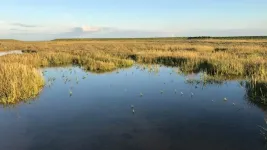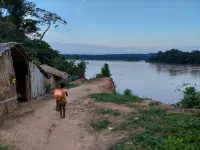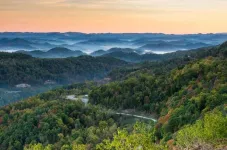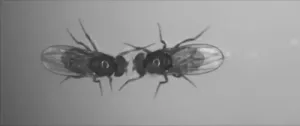(Press-News.org) The record storm surge in October 2023 caused severe damage to the German Baltic coast. Effective adaptation scenarios to rising sea levels are therefore becoming increasingly urgent. In two recent studies, researchers at Kiel University have modelled both the flooding extent along the Baltic Sea coastal areas and, for the first time, two possible upgrades for current dike lines in high resolution. They modelled various storm surge and sea level rise scenarios. Their results show that, based on the current dike line, neither an increase nor managed realignment, i.e. controlled breaching of seaward defences and relocation of primary defence line further inland, as a nature-based solution can be sufficient to protect people, infrastructure or buildings to significantly reduce the risk of flooding along the German Baltic Sea coast by the year 2100. In the model, the risk for the population compared to today's existing coastal protection was only reduced by a maximum of 26% for the scenario of managed realignment. Their results were published on 24 November in the journal Communications Earth & Environment and at the beginning of September in Natural Hazards and Earth System Sciences.
"The majority of our simulated flooding areas are located in Mecklenburg-Western Pomerania, with the hotspots in the lagoons of Fischland-Darß-Zingst, Rügen, Usedom and the Peene estuary. In Schleswig-Holstein, the Flensburg Fjord, Eckernförde Bay, Fehmarn, Travemünde and Lübeck are particularly affected", says first author Dr Joshua Kiesel, postdoctoral researcher in the Coastal Risks and Sea Level Rise working group at the Institute of Geography at Kiel University. Professor Athanasios Vafeidis, co-author of both studies and member of the research priority area Kiel Marine Science (KMS) at Kiel University, leads the working group. "Today, we can still decide for a large part of the German Baltic Sea coast what an adaptation might look like in the future. The known disadvantages of existing dikes should definitely be taken into account”, says Vafeidis. According to the researcher of Kiel University, this is also crucial for protection against future extreme events, which are very likely to become more frequent.
Process-based modelling helps to evaluate adaptation scenarios
Today, nature-based adaptation options are becoming increasingly important. One example of this is managed realignment, which aims to create a natural buffer zone between the sea and the dike. In this buffer zone, coastal wetlands can (re)establish, whose vegetation increases the surface roughness and thus makes a natural contribution to coastal protection. Rare habitats such as salt marshes and reed beds can develop in these buffer zones, which also contribute to the preservation of biodiversity.
Previous models simulate flooding according to the principle of a uniform spread of water when storm surges hit the coast. In the current, process-based modelling, the researchers now also take into account the temporal course of storm surges as well as the attenuation of the surge with its currents and peak water levels when it hits areas of varying roughness, such as wetlands, forests or paved soils. "Compared to previous supra-regional or continental studies, our coastal flooding model is the first to use high-resolution terrain data from state and regional dikes with a resolution of one metre for the entire German Baltic Sea coast. This enabled us to assess the effectiveness of existing and raised dikes on the one hand and of managed realignment on the other. However, based on current defence lines, both will probably not be sufficient to withstand the ongoing sea level rise", says coastal geographer Kiesel.
However, Kiesel and the research team estimate that the protection potential for managed realignment, including raising them, is greater than raising them without realignment. "Managed realignment means that existing dike lines are breached to reestablish regular flooding and sedimentation of low lying areas. This approach typically involves the construction of a new dike line further inland to protect adjacent people, buildings and infrastructure. There are already several examples of managed realignment along the German Baltic coast", says the scientist. During very high surges, the slightly improved coastal protection function is due to the significantly longer, landward dike line.
In order to identify physically plausible areas for managed realignment, the scientists based their study on several parameters: no direct development behind the dike and no infrastructure in the form of roads or railway networks. In order to compare the effectiveness of dike relocation with conventional coastal protection, all state and regional dikes along the German Baltic Sea coast were also raised by 1.5 metres in accordance with the climate dike concept. "There is a broad scientific debate about managed realignment and nature-based adaptation options in general. However, there has been little research into their effectiveness in terms of coastal protection. Our research fills a gap here. We wanted to know what contribution managed realignment can make to regional coastal protection if it is implemented wherever it is physically possible", says Kiesel. For this reason, socio-economic considerations and the frequent lack of acceptance among the population for such measures, which also involve interventions in the infrastructure, were not taken into account.
Flood maps for the German Baltic Sea coast
In their first study from September 2023, around a month before the severe storm surge, the research team led by Kiesel and Vafeidis had already been able to prove with two high end sea level rise scenarios that the entire German Baltic Sea coast is at high risk of flooding and that upgrades to coastal protection are necessary. To do this, they coupled a model of the western Baltic Sea with a coastal flooding model.
The spatial information on dikes and vegetation usually requires good local knowledge and cooperation with the authorities. "Without our transdisciplinary approach, we would not have been able to provide our flood maps in this resolution", adds co-author Vafeidis, whose working group works closely with the state authorities.
"Now, not later": More research into adaptation concepts
With the climate dike concept of the state of Schleswig-Holstein and the planned dike constructions along the German Baltic Sea coast, the first coastal protection measures are already underway. Kiesel, who now works as a research assistant at the Free University of Amsterdam, would like to continue working closely together in the future: "We need more research into the effectiveness of nature-based adaptation options. The dramatic events of the Baltic Sea storm surge have shown that we should start today if possible. Successive storm surges in a short period of time could also become more frequent in the future. The infrastructure already weakened by the first storm surge would be much more vulnerable to subsequent events, with even worse consequences for the people on the coast."
Developing new and effective adaptation concepts are a challenge that not only countries and people on the German Baltic coast are facing. Such risks are also increasing in Europe. Vafeidis' working group is researching European solutions in the EU Horizon 2020 project "Coastal Climate Core Services" (CoCliCo).
The research results of the two studies were produced in the project "Ecosystem-supporting Coastal Adaptation Strategies for the German Baltic Sea Coast" (ECAS-Baltic), which is funded by the German Federal Ministry of Education and Research (BMBF). The project was coordinated by the Global Climate Forum (GCF) in Berlin. In addition to Kiel University with its coastal geology and coastal geography, the following institutions were involved in the ECAS-Baltic project: the Ludwig Franzius Institute for Hydraulic, Estuarine and Coastal Engineering, Leibniz University Hannover, the Helmholtz Centre Hereon, the Leibniz Institute for Baltic Sea Research Warnemünde (IOW) and the two universities of Rostock and Greifswald.
Original publications:
Kiesel, J., Honsel, L.E., Lorenz, M., Gräwe, U. and Vafeidis, A.T.: Raising dikes and managed realignment may be insufficient for maintaining current flood risk along the German Baltic Sea coast. Commun Earth Environ 4, 433 (2023). DOI: 10.1038/s43247-023-01100-0
Kiesel, J., Lorenz, M., König, M., Gräwe, U., and Vafeidis, A.T.: Regional assessment of extreme sea levels and associated coastal flooding along the German Baltic Sea coast, Nat. Hazards Earth Syst. Sci., 23, 2961–2985 (2023). DOI: 10.5194/nhess-23-2961-2023
Photos are available for download:
www.uni-kiel.de/de/pressemitteilungen/2023/299-schilfguertel-deich.jpg
Reed belt in front of a dike section on the Holnis peninsula in Schleswig-Holstein
© Tobias Hahn, Kiel University
www.uni-kiel.de/de/pressemitteilungen/2023/299-joshua-kiesel.jpg
Dr Joshua Kiesel is the first author of both studies and was a postdoctoral researcher in the Coastal Risks and Sea Level Rise working group at the Institute of Geography at Kiel University. He is now a research associate at the Free University of Amsterdam.
© Svenja Karstens, Kiel University
www.uni-kiel.de/de/pressemitteilungen/2023/299-kontrollierte-deichrueckverlegung-england.jpg
Nature-based adaptation options in the event of rising sea levels are attracting increasing attention. One example of this is managed realignment, which aims to create a natural buffer zone between the sea and the dike. Existing dike lines are breached to reestablish regular flooding and sedimentation of low lying areas. This is a common procedure in Freiston Shore, England, for example.
© Joshua Kiesel, Kiel University
www.uni-kiel.de/de/pressemitteilungen/2023/299-fischlandwiesen.jpeg
Coastal wetlands increase the surface roughness with their vegetation and thus make a natural contribution to coastal protection. As a buffer zone, salt marshes are also effective carbon reservoirs and a nursery for fish and birds.
© Joshua Kiesel, Kiel University
www.uni-kiel.de/de/pressemitteilungen/2023/299-potentielle-deichrueckverlegungsflaechen-studie.png
Study area and potential managed realignment sites across the German Baltic Sea coast: The detection of managed realignment sites excludes all areas in which major roads, railways or any kind of development occur and which are higher than ten metres above sea level.
© Kiesel, J. et al. (2023), Commun Earth Environ
Background information on dike construction measures on the Baltic Sea coast:
Dikes can create a sense of security among the population and enable or even encourage human development directly behind the dike. This can paradoxically increase the risk of flooding, which is described in science as the Levee effect. At the same time, dikes reduce the adaptability of ecologically valuable coastal wetlands, which increase the surface roughness with their vegetation and thus make a natural contribution to coastal protection.
Low-lying land behind dikes is often drained for further utilisation and the regular supply of sediment through flooding does not occur, which prevents the land behind the dikes from growing at the same rate as the sea level. There is therefore a lack of sediment and at the same time the land sinks as a result of drainage, in some areas to below mean sea level. The loss of coastal wetlands and sinking land further increase the risk of flooding. For this reason, nature-based adaptation options are now receiving increasing attention. One example of this is controlled dike relocation, which aims to create a natural buffer zone between the sea and the dike. Rare habitats such as salt marshes and reed beds can develop in these buffer zones, particularly on the German Baltic Sea coast, thus contributing to the preservation of biodiversity.
About the Coastal Risks and Sea-Level Rise (CRSLR) research group:
The research group "Coastal Risks and Sea-level Rise" (CRSLR) at Kiel University currently has a total of ten scientists working and is headed by Professor Athanasios Vafeidis. The team assesses the extent of climate change-induced impacts on coastal regions worldwide and conducts research on how coastal systems respond to the combined pressures of natural and anthropogenic factors. Using data from observations and modeling as well as long-range, scientific analyses, the researchers focus on coastal adaptation, coastal population trends, and coastal influence and vulnerability analysis. Their research activities also include the EU Horizon 2020 Coastal Climate Core Services (CoCliCo) project, which runs through September 2025. The project aims to better inform decision makers about coastal protection measures and adaptations to sea level rise and associated, future hazards to the population.
About Kiel Marine Science (KMS):
Kiel Marine Science (KMS), the Center for interdisciplinary marine science at Kiel University, is devoted to excellent and responsible ocean research at the interface between humans and the ocean. The researchers combine their expertise from various natural and social science disciplines to investigate the risks and opportunities that the sea provides for humans. The success of Kiel Marine Science is based on close interdisciplinary cooperation in research and teaching between researchers from seven faculties at Kiel University. Together with actors from outside the scientific community, they work globally and transdisciplinarily on solutions for sustainable use and protection of the ocean.
More information:
To the webseite of the CRSLR-research group
About the BMBF-Project ECAS-Baltic
About the EU-Project CoCliCo
Scientific Contacts:
Dr Joshua Kiesel
Research group Coastal Risks and Sea-Level Rise
Kiel University
Institute for Environmental Studies (IVM)
Vrije Universiteit Amsterdam (VU)
E-mail (CAU): kiesel@geographie.uni-kiel.de
E-mail (VU): j.kiesel@vu.nl
Prof. Athanasios Vafeidis
Research group Coastal Risks and Sea-Level Rise
Institute of Geography
Kiel University
E-mail: vafeidis@geographie.uni-kiel.de
Press Contact:
Tobias Hahn
Public Outreach / Science Communication
Press, Digital and Science Communication Services and Kiel Marine Science (KMS)
Kiel University
E-mail: thahn@kms.uni-kiel.de
Telephone: +49/431/880-7185
Kiel University
Press, Communication and Marketing, Eva Sittig, Text/editing: Tobias Hahn
Postal address: D-24098 Kiel, Germany, Telephone: +49 431 880-2104, Fax: +49 431 880-1355
E-mail: presse@uv.uni-kiel.de, Internet: www.uni-kiel.de Twitter: www.twitter.com/kieluni
Facebook: www.facebook.com/kieluni Instagram: www.instagram.com/kieluni
END
Being prepared for storm surges on the Baltic Sea coast
Kiel researchers evaluate the future protection potential of dikes and show flooding scenarios for the German Baltic Sea coast until 2100
2023-11-29
ELSE PRESS RELEASES FROM THIS DATE:
Findings challenge standard understanding of COVID-19 infection
2023-11-29
RIVERSIDE, Calif. -- Some viruses move between species. For example, SARS-CoV-2, the virus that causes COVID-19, can spill over from humans to mink, an agricultural species, and then spill back from mink to humans. Spill back is a concern because SARS-CoV-2 can mutate in the mink and come back to humans in a more virulent form. Both spill over and spill back of SARS-CoV-2 have been reported on mink farms in the United States and Europe.
To address these issues, a research team at the University of California, Riverside, has ...
Building the digital replica of our seas: an open call for crucial biodiversity data to restore ocean ecosystems
2023-11-29
The Horizon Europe DTO-BioFlow project (https://dto-bioflow.eu) has launched an Open Call offering up to 60,000€ for institutions that manage marine biodiversity data, to invite them to contribute to the European Digital Twin of the Ocean (EU DTO) by making these data available to the public domain through EMODnet Biology, the portal that provides open and free access to interoperable data and data products on temporal and spatial distribution of marine species (angiosperms, benthos, birds, fish, macroalgae, mammals, reptiles, phyto- and zooplankton) from European regional seas. Published officially on Tuesday, October 31st, this single-stage call is open to a wide ...
New research sheds light on Bantu-speaking populations' expansion in Africa
2023-11-29
About 350 million people across Africa speak one or more of the 500 Bantu languages. New genetic analysis of modern and ancient individuals suggests that these populations probably originated in western Africa and then moved south and east in several waves. The study has been published in the scientific journal Nature.
The expansion of people speaking Bantu languages is considered one of the most dramatic demographic events in Late Holocene Africa, which began 6,000 to 4,000 years ago in western Africa. This new study generated and analysed a comprehensive dataset, including genomic data of modern-day populations from 1,763 participants ...
Popularity matters more than compatibility on dating apps
2023-11-29
A new study has found that algorithms used by online dating platforms have popularity bias - meaning that they recommend more popular, attractive users over less popular, less attractive users. Researchers at Carnegie Mellon University and the University of Washington published their findings in Manufacturing & Service Operations Management.
They evaluated data from over 240,000 users of a major online dating platform in Asia over three months. They found that a user's chance of being recommended by the platform's algorithm ...
Markey Cancer Center research highlights need for education to combat cancer in Appalachia
2023-11-29
LEXINGTON, Ky. (Nov. 29, 2023) — University of Kentucky Markey Cancer Center research underscores the need for interventions to increase educational attainment and knowledge of cancer in Appalachian Kentucky.
Kentucky has the highest rate of cancer incidence and mortality in the country, with the Eastern Appalachian region bearing the highest burden due to health, socioeconomic and education disparities including decreased education attainment levels that cause lower health ...
Contraception: hormonal and copper coil only show minor differences
2023-11-29
In the “ThemenCheck Medizin” procedure offered by the German Institute for Quality and Efficiency in Health Care (IQWiG), interested members of the public can submit proposals for the assessment of medical procedures and technologies. On behalf of IQWiG, an interdisciplinary team of researchers led by Share to Care GmbH in Cologne investigated the advantages and disadvantages of two types of contraceptive coils (also known as intrauterine devices, IUDs) for preventing unwanted pregnancies, the copper IUD and the hormonal IUD.
Their conclusion: both types of IUDs are very safe and, compared to condoms or the pill, cost-effective contraceptive ...
The chip that makes calculations with light
2023-11-29
Optical wireless may no longer have any obstacles. A study by Politecnico di Milano, conducted together with Scuola Superiore Sant'Anna in Pisa, the University of Glasgow and Stanford University, and published in the prestigious journal Nature Photonics, has made it possible to create photonic chips that mathematically calculate the optimal shape of light to best pass through any environment, even one that is unknown or changing over time.
The problem is well known: light is sensitive to any form of obstacle, even very small ones. Think, for example, of how we see objects when looking through a frosted window ...
Severe weather disproportionately impacts Oklahoma’s native communities, study shows
2023-11-29
As the climate, demographics and land usage continue to change, tribal communities in Oklahoma are increasingly at risk of severe weather. A recent study led by Yang Hong with the University of Oklahoma examines these changes and the risks they pose.
“Indigenous communities are grappling with an imminent climate crisis compounded by systemic injustices. Recognizing their unique connections to their homelands as sovereign peoples is crucial in addressing these pressing issues,” Hong said.
Hong is the corresponding author of the paper, “Future ...
JMIR Publications announces a partnership with leading career center provider Naylor Association Solutions to power a brand-new online career development hub for digital health professionals
2023-11-29
We are thrilled to announce the official launch of the JMIR Career Center on the JMIR Publications website. This pioneering platform is set to revolutionize the way healthcare professionals access career development resources and opportunities within the digital health field.
The JMIR Career Center, in collaboration with Naylor Association Solutions, aims to bridge the gap between digital health professionals and their career advancement. As the digital health sector continues to evolve, so too does the demand for skilled and motivated professionals. By providing a dedicated hub for digital health career resources, job ...
Fighting fruit flies help researchers understand why we stay angry
2023-11-29
It’s one of those days. On the drive home from work, the car in the next lane cuts you off. You slam on the brakes, lay on the horn, and yell choice words at the offending driver. When you walk into your house half an hour later, you’re still angry, and snap at your partner when they ask about your day.
Fruit flies may not have to worry about the lingering effects of road rage, but they also experience states of persistent aggression. In the case of female fruit flies, this behavior is a survival mechanism, causing the flies to headbutt, shove, and fence other female fruit flies to guard prime egg-laying territory on a ...
LAST 30 PRESS RELEASES:
Injectable breast ‘implant’ offers alternative to traditional surgeries
Neuroscientists devise formulas to measure multilingualism
New prostate cancer trial seeks to reduce toxicity without sacrificing efficacy
Geometry shapes life
A CRISPR screen reveals many previously unrecognized genes required for brain development and a new neurodevelopmental disorder
Hot flush treatment has anti-breast cancer activity, study finds
Securing AI systems against growing cybersecurity threats
Longest observation of an active solar region
Why nail-biting, procrastination and other self-sabotaging behaviors are rooted in survival instincts
Regional variations in mechanical properties of porcine leptomeninges
Artificial empathy in therapy and healthcare: advancements in interpersonal interaction technologies
Why some brains switch gears more efficiently than others
UVA’s Jundong Li wins ICDM’S 2025 Tao Li Award for data mining, machine learning
UVA’s low-power, high-performance computer power player Mircea Stan earns National Academy of Inventors fellowship
Not playing by the rules: USU researcher explores filamentous algae dynamics in rivers
Do our body clocks influence our risk of dementia?
Anthropologists offer new evidence of bipedalism in long-debated fossil discovery
Safer receipt paper from wood
Dosage-sensitive genes suggest no whole-genome duplications in ancestral angiosperm
First ancient human herpesvirus genomes document their deep history with humans
Why Some Bacteria Survive Antibiotics and How to Stop Them - New study reveals that bacteria can survive antibiotic treatment through two fundamentally different “shutdown modes”
UCLA study links scar healing to dangerous placenta condition
CHANGE-seq-BE finds off-target changes in the genome from base editors
The Journal of Nuclear Medicine Ahead-of-Print Tip Sheet: January 2, 2026
Delayed or absent first dose of measles, mumps, and rubella vaccination
Trends in US preterm birth rates by household income and race and ethnicity
Study identifies potential biomarker linked to progression and brain inflammation in multiple sclerosis
Many mothers in Norway do not show up for postnatal check-ups
Researchers want to find out why quick clay is so unstable
Superradiant spins show teamwork at the quantum scale
[Press-News.org] Being prepared for storm surges on the Baltic Sea coastKiel researchers evaluate the future protection potential of dikes and show flooding scenarios for the German Baltic Sea coast until 2100






